Stereo!
Stereo!
Samba Do Avião, by Antonio Carlos Jobim 1965, Encountered 1965
When it came to technology, my two sets of parents could not have been further apart.
My mom and stepfather resisted each advance in consumer electronics. Television, as I’ve written, was kept out of the house until 1964, and then only was allowed in because my father’s grandmother had died and left her set behind. They insisted on telephone operators making their long distance connections for them for as long as that was a viable option, and one of the first skills my mom lost later on when dementia set in was dialing the phone (I think because it called for 10 digits as opposed to the six or seven that had prevailed earlier in her life). They never mastered the VCR I gave them or the microwave. Though each wielded the typewriter a lot, there was never an electric typewriter in the house, let alone a PC (and each lived over a decade after PCs became commonplace, my mother more than two).
Stereo!
My father, by contrast, loved gadgets, especially gadgets connected with music reproduction. In his mountain getaway cottage, there was a trestle table with nothing but hi-fi, or as we came to call it, stereo gear: turntables, tape recorders, amps, pre-amps, tuners, speakers, headphones, all patched together in unique ways. It wasn’t always a success from an audio reproduction standpoint, and was never ever very sightly, but my stepmother did not mind, bless her. One of my real regrets about losing him so early (1978) was that he didn’t live to see the dawn of the really good gadgets. Of course he would have been about 90 year old when iPods arrived, 100 years old when Blu-Ray came in, so if he had lived that long, who knows if he would have kept his zest for mechanical novelty late enough in life to enjoy them.
But in the times I’m speaking of now, he was the guy who opened the wonderful world of sound-making gadgets to me. Somewhere around 1964, probably for my birthday, he provided me some entry-level but serious hi-fi gizmos. I’ve tried to provide pictures that approximate these treasures, though images of the precise models elude me on the Net.
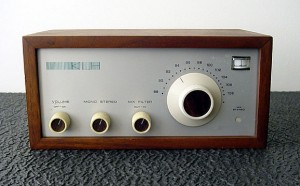
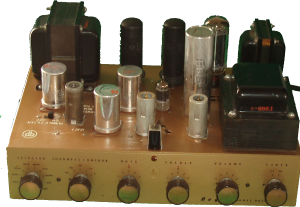
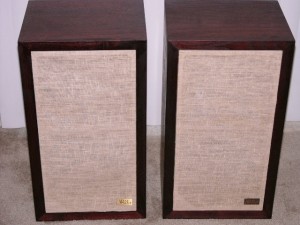 [2] This setup was my pride and joy.
[2] This setup was my pride and joy.
Now you’ll note that in the endnote above describing all this, I mention only a single speaker. I think that one was all my dad could spring for at that time. So though it was definitely the most sophisticated rig in my mom and dad’s household, it remained mono for a while. I knew that stereo was supposed to be way better, but I couldn’t just go out and buy a quality speaker. If I wanted one, I had to save up for it. And I think I put money away for a year. I believe it was shortly after my 16th birthday in the summer of 1965 that I had the necessary coin gathered together. I went out to a store called Schochet’s (I think), put down my money on a companion speaker, and waited a week or so for delivery.
Eventually, I got the second speaker home, hooked it up with the heavy-gauge transparent wire, flipped the switch on the amp from mono to stereo, and cued up my first stereo record. And that, I believe, was The Wonderful World of Antonio Carlos Jobim. As readers of these pieces know, I was all about discovering rock right then, so an album of bossa nova might have seemed like an odd choice. But I was always a musical omnivore, and bossa nova, not to mention Jobim, was all over everyone’s radar screen[3] after The Girl From Ipanema[4] had become the Grammy Record of the Year in 1964. And I think I was also aware that the acoustic impact of an album like this was likely going to be greater than that of a collection of rock music. I probably didn’t recognize the name of the arranger and conductor, the great Nelson Riddle, whose name would have clued me in, but I believe I’d heard (probably read in Stereo Review, which I’d begun subscribing to) that the sound of the album was gorgeous.
So there I was, tone arm posed over the black vinyl with the gold Warner Bros. label in the middle, with “STEREO” written in an arc across the bottom in big red letters. The needle dropped, and I was transported. When I closed my eyes, I was in a different aural space, floating out there somewhere with the strings. It sounded as if Jobim was singing and strumming his guitar up close to you, with a chorus of growling trombones behind him in the middle distance, percussion to the left, piano to the right, while strings encamped all the way out to the luminous horizon.
Damn! This was stereo!
I just kept playing it. I’d keep coming back to those two speakers and the fact that I could close my eyes and lose myself in an imaginary space. I was so taken with the sound that the music almost didn’t matter to me for a while.
Faraway Lands
Of course eventually I stopped listening to the sound and started paying attention to the record. I’m not sure I found the music overwhelming. I think the effect was subtle, like the very sound of the bossa nova itself. Still that rich Nelson Riddle orchestral palette (the trademark, for instance, of some of the great Frank Sinatra albums of the late 50s and early 60s) elucidated part of the truth about bossa nova, which is that, while it may be quiet and subtle, it’s often about passion and excitement. It’s not just in the breathless frustrated eroticism of The Girl From Ipanema that appears in this album, a song which everyone knows is about the habitués of a seaside bar watching a passing 15-year old girl with hopeless and slightly inappropriate lust. On this very album you can hear Surfboard, which somehow captures the thrill of waiting for and then riding a wave.
And then there’s Samba Do Avião, which is about riding a plane coming in for a landing at Rio de Janeiro’s Galeão Airport, and looking down at the town as one goes. (Not coincidentally, I’m sure, Galeão is now called Antonio Carlos Jobim.) And maybe a word needs to be said about exactly why this is so exciting
Avião is just Portuguese for airplane. But this was an era in which airplanes were conjuring up new feelings. Take a look at the TWA-branded cover of Come Fly With Me, Sinatra’s 1957 smash album (well, recorded in 1957, released in 1958). Notice something odd to modern eyes about the aircraft? They were prop-driven. Yet in the iconography of that cover, these old-timey planes are the 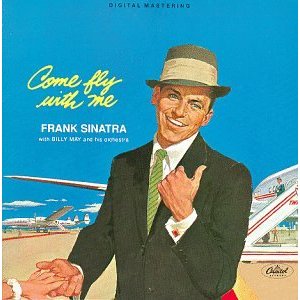 magic carpets to carry the lucky listener to all the destinations Sinatra sings about: New York, Paris, Capri, Brazil, Hawaii, etc.[5] 1957 was also the year the Boeing 707 was first licensed for commercial flight. And people my age will recall that the 707, followed shortly by the DC-8, changed everything, glamorized everything, about air travel. By 1965, a song about taking off in an airplane (all right, this song is about coming in for a landing, but I didn’t know that) would have had the listener thinking about being thrust unaccustomedly back against the cushions, about plunging recklessly upward, about sexy stewardesses (sorry, “flight attendant” was a neologism years away), and about getting to interesting places ridiculously fast. Not to mention that the most glamorous folks in the world were called the Jet Set then. And this was all new.[6]
magic carpets to carry the lucky listener to all the destinations Sinatra sings about: New York, Paris, Capri, Brazil, Hawaii, etc.[5] 1957 was also the year the Boeing 707 was first licensed for commercial flight. And people my age will recall that the 707, followed shortly by the DC-8, changed everything, glamorized everything, about air travel. By 1965, a song about taking off in an airplane (all right, this song is about coming in for a landing, but I didn’t know that) would have had the listener thinking about being thrust unaccustomedly back against the cushions, about plunging recklessly upward, about sexy stewardesses (sorry, “flight attendant” was a neologism years away), and about getting to interesting places ridiculously fast. Not to mention that the most glamorous folks in the world were called the Jet Set then. And this was all new.[6]
Even if it weren’t, it had the association of forbidden fruit for me. My Luddite mom and stepdad were deathly afraid of my flying. As a result, with but one exception (still in the prop craft era), all the comings and goings between my home in Ann Arbor and my home in New York were by car or rail. I had some wonderful rail and road experiences that way, but obviously the fact that my mom wouldn’t let me made me all the eagerer to fly. And the song made it possible to do in my imagination, at least.
So that song carried those associations for me. I’d also seen That Man from Rio, with Jean-Paul Belmondo and Françoise Dorléac, twice, the previous year. So I knew what the statue of Cristo Redentor that the singer admires looked like, and about the staggering hills above Rio. I knew it was an exotic land well worth visiting. In short, I was a sitting duck for the way the song, even in a language I didn’t grasp much of, [7] evoked its subject.
So this was a part of my introduction to the stereophonic effect, to the sounds of bossa nova, and to the lust for travel. And that’s why it’s a Theme Song for me.
[1] This is not the version on the album (Jobim shares the singing with others), but it gives you an excellent idea of the meaning of the song.
[2] At the heart there was a Bogen tube amp, which I believe was sold with or without a cover, and my dad opted for the without (probably as an economy measure), but that way I could see and marvel at the vacuum tubes, so I never minded. This amp included preamplification, so I never had a separate unit. The amp fed an AR-15 speaker in a heavy solid wood casing; Acoustic Research being the dominant quality speaker manufacturer of the day. Feeding signal into this assemblage was a 3-speed turntable, which I think was a Garrard, though I barely remember this item (and haven’t included a photograph), and a KLH FM-only tuner, although very little of interest to me was yet found on the FM band. The KLH was also encased in solid wood, and was just elegant to the eye.
[3] In terms of my radio station influences, I’m guessing this one came by WJR rather than my rock stations, though I can’t be sure about this, as the Top 40 format was pretty catholic in its breadth, extending as far as jazz, country, and folk at times.
[4] There’s also an interesting black-and-white TV transcription of Astrud Gilberto singing and Stan Getz playing his unforgettable saxophone accompaniment here.
[5] Interestingly, an Amazon poster has shared a poster from the Sands Hotel of what must have been about the same era, that updates the image with a jet.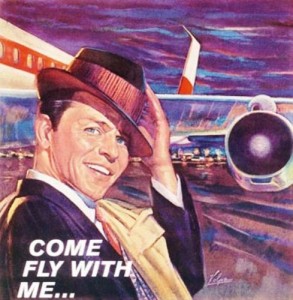
[6] WJR had an all-night program called Night Flight (described by one listener as a “classics, light music, and light jazz show”) that I frequently fell asleep listening to, described in various comments here (see especially the remarks of Don Stoffel). And I think that maybe some version of Samba Do Avião was the theme; if not, then something along the same lines. The gimmick was that the commencement of the show would be the takeoff, and you’d set course for somewhere, often somewhere exotic, and at the end of the show you’d come in for a landing with airplane landing sounds. (Frequently those sounds would awaken me.)
[7] I don’t claim I understood all the words in 1965. But I recognized a reference to the statue of Cristo Redentor, got it that the singer is looking down at Rio from above, and the only thing I actually got wrong was, as described above, that I thought the plane was taking off, not coming in for a landing.
Copyright (c) Jack L. B. Gohn (except for photographic elements of the posting which may belong to others)
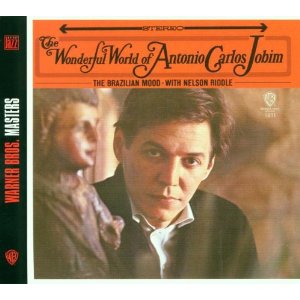
Oh, how familiar that stereo equipment looks. Larry built a system with parts from the same company, KLY, that mention. He had great fun putting the thing together, but I don’t remember the sound being particularly impressive. I do remember those speakers, encased as you say in solid wood, weighing a ton! We too had a Gerrard turntable – very modern! We even had a smoke-brown plastic cover for the turntable.
I love Getz & Gilberto and Antonio Carlos Jobim and the bosa nova sound, even today. I think we may have an old album or two in the basement.